|
|
| What SCOsource was for, Part I - Updated |
 |
|
Wednesday, February 13 2008 @ 04:01 PM EST
|
I think I've finally figured out what SCOsource was for.
I've been reading Novell's Motion for Summary Judgment on its 4th Claim for Relief and looking over the exhibits that SCO attached to the Brent Hatch Declaration in support of its sealed opposition to it, trying to understand both parties' positions, and I think neither has the story exactly right yet. So I thought it might be worthwhile to lay out all the evidence I could about SCOsource. That involves quite a few screenshots and links, so this will be a multi-part article. Part I will simply explain the difference between Unix Sys V and Unixware, such as it is and according to how I understand it, because we need to understand that in order to follow the twists and turns of the SCOsource offerings.
Novell argues that SCOsource was really all about SVRX, not UnixWare, that SCO never claimed that Linux violated UnixWare IP, and that since SCO only had a right to modify or enter into new licenses if SVRX was "incidental" to a UnixWare license, SCO lacked any right to enter into the Sun, Microsoft and other SCOsource licenses. "The Asset Purchase Agreement prohibits SCO from modifying existing SVRX Licenses and from entering into new SVRX Licenses," Novell tells the court, and any buyout required Novell's OK. Obviously SCO wishes to argue the opposite. SCO's memorandum in opposition is under seal, so I reread their Memorandum in Support of its Motion for Reconsideration or Clarification of the August 10, 2007 Ruling [PDF] to refresh my memory on what the SCO position was. That should give us the ballpark, at least. Essentially, the argument was that SCOsource wasn't about IP -- it was a promise not to sue. The issue in this motion, then, is did SCO have the right under the terms of the APA to enter into the licenses with Microsoft and Sun and other SCOsource licensees? The problem with framing the argument in the context of the APA is that neither of the signatories to that agreement ever dreamed of anything as odd as SCOsource. The best one can do is decide if the licenses were more for Unixware or for SVRX. SCO got nowhere with its motion for reconsideration, because if you sell an IP license, you can't really say that it has nothing to do with IP. And if it's about IP, is it SVRX IP or Unixware IP? It's an artificial problem, brought about by the need to make what SCO did fit into the APA context, so the money folks paid for SCOsource licenses ends up in the correct hands. As I'll show you, in my view there are two additional ways to decide what category the license was for by answering two questions: 1. what did the licensee use the license for -- what did it cover?
2. What did they pay for it? The reason I view it that way is because there was more than one kind of SCOsource deliverable, as I'll show you, and what SCO said SCOsource was for morphed over time. SCO was always rather mysterious about what IP it was talking about, but we can rely upon their own descriptions, I would think.
Update: An anonymous comment provides a very logical way to make the determination: The only SysV stuff SCO was allowed to sell was the code "incidental"
to Unixware. A simpler view of the whole thing is was it a Unixware license? If
not then SCO did not have the right to sell it.
So when customers paid for an SCOsource license if they did not get Unixware
operating on that system, then SCO was stepping outside of the domain it was
allowed to operate in. End of update.
So we'll talk about all that, mainly in Part II. But first, in Part I, to understand SCOsource, we need to explain the difference between Unix and UnixWare.
What is UnixWare?
In the first footnote in SCO's Memorandum in Support of its Motion for Reconsideration or Clarification of the Court's August 10, 2007 Order that it filed last August, and which the court denied, SCO explained it like this: In fact, UnixWare is not a separate system, but rather is just the latest version of SVRX; much of the code in UnixWare previously appeared in previous SVRX releases or is based on code from previous SVRX releases.
That's not quite accurate, since they are not identical, as I'll explain in a minute, but it's accurate that UnixWare is based on SVRX and it incorporates the SVRX kernel. So any issue about IP isn't about a difference in the code. It's more a difference in what a client wanted and what it ordered. In the APA sense, that mattered in terms of who got the money and what SCO was allowed to do, but in a code sense, there is very little difference. UnixWare was the same code, but with some things added to make it a binary product, including things which SCO never owned, various applications and userfriendly things. If all you wanted was to run Unix as an operating system, you bought UnixWare. If you wanted source code to develop your own version of Unix, like IBM's AIX, then you wanted the Sys V code itself. OldSCO, now Tarantella, sold a variety of Unix-based products, not just UnixWare. Let's take a look at that.
This Tarantella 10K tells us the history of oldSCO's product line: The Santa Cruz Operation, Inc. (SCO or the Company) was incorporated in
California in 1979 and shipped its first product, SCO(R) XENIX(R) System V, a
packaged version of the UNIX(R) operating system, in 1983. In 1985, the Company
introduced its first operating system for the 32-bit Intel(R) microprocessor
environment, SCO XENIX 286, and followed with its SCO XENIX 386 in 1987. The
Company first shipped its UNIX trademarked commercial product, SCO UNIX System
V/386, for the Intel CPU-based platforms in 1989 and followed with an
integrated, graphical version of this product, SCO Open Desktop(R), in 1990. In
1993, the Company introduced two families of systems software -- SCO
OpenServer(TM) products, a complete line of advanced server and SCO Open Desktop
products, a complete line of advanced workstation (client) operating systems. In
1995, SCO integrated these products into a single line, called the SCO
OpenServer family. SCO also introduced its SCO Vision family of
client-integration products, which integrate Windows(R) PC's with UNIX Servers
from all major UNIX vendors. SCO also created a Layered Server Products division
which has the mission of providing middleware that enhances the capabilities of
SCO OpenServer Systems, as well as UNIX Servers from other vendors. In fiscal
year 1996, SCO acquired the UnixWare(R) and UNIX System V Release 4
source-license business from Novell, Inc....
FOCUS ON TARGET MARKETS
SCO focuses its products, industry relationships, distribution and support
strategy on three key business opportunities: primary information systems for
small and medium-sized businesses; replicated systems for use in distributed
information systems in medium-sized and large organizations, including Fortune
1000 corporations; and business-critical enterprise systems for large and
medium-sized businesses. Key targeted industries include retail, finance and
banking, government, distribution, telecommunications, transportation and
manufacturing....
PROVIDE TRUE OPEN SYSTEMS PRODUCTS
Because customers are increasingly reluctant to be restricted to a single
computer vendor, the Company has designed its software products to support
industry-accepted open systems standards. Open systems are those systems which
conform to established industry standards such as XPG-4, Spec 1170, DCE and
OSF/Motif(R) from The Open Group, POSIX(R) from IEEE, and Federal Information
Processing Standard (FIPS) from the National Institute of Standards (NIST). SCO
continuously works with standards organizations such as The Open Group to assure
continued conformance to open systems standards. Industry standards may be
established by organizations composed of vendors, by government agencies, by
academic institutions, or by market acceptance. Industry standards typically are
based on specifications which allow competing implementations. Because these
standards are open, competitors can readily access the technology to include in
their products. Industry standards offer the customer a cost-effective computing
solution by providing a high degree of compatibility and interoperability among
hardware, software, network and peripheral products. Based on published
directories listing vendors and applications, the Company believes there are
currently over 15,000 business critical software solutions compatible with SCO's
products....
The Company has established a program
to focus on the use of SCO products at schools and universities, and in 1996
made free copies of its UNIX server licenses available to non-commercial
organizations.
Here's more info on the free Unix and UnixWare 7 Release 7.1 licenses, if you are interested. So oldSCO, or Tarantella, sold a number of Unix-based products, starting with Xenix and then OpenServer, and then after the deal with Novell, it sold UNIX and UnixWare too. Some customers wanted more than one product. In this Tarantella 10K for the fiscal year ending September 30, 2001, we find out how they allocated OpenServer and UnixWare monies from contracts involving both: Until May 2001, the Company sold two types of software product -- its UNIX based
operating system software, which was sold under the Unixware and OpenServer
names, and its application broker software sold under the Tarantella name. In
May 2001, the Company sold the UNIX based business to Caldera Systems, Inc.
The Company sold Unixware and OpenServer products separately and as a result,
contracts involving the sale of Unixware and OpenServer which contain multiple
obligations (e.g. delivered and undelivered products, maintenance and other
services), the Company allocated revenue to each component of the contract based
on objective evidence of its fair value, which is specific to the Company. The
fair value of each element is based on the price sold separately.... The Company recognizes product revenue from royalty payments upon receipt of
quarterly royalty reports from OEMs (original equipment manufacturer) related to
their product sales.... They drew the line at 15%, as you can see in the Third Amendment to the Caldera-OldSCO APA: "OpenServer Business" means the business of SCO and its direct
and indirect subsidiaries with respect to the OpenServer Products, including
without limitation the business of developing, manufacturing, marketing,
licensing, distributing, using, operating, installing, servicing, supporting,
maintaining, repairing or otherwise using or commercially exploiting the
OpenServer Products; provided, however, that the OpenServer Business shall in no
way include any other line of business of Newco, notwithstanding that such other
line of business may incorporate OpenServer kernel or library code that
implements less than 15% of the OpenServer Application Binary Interfaces.
You want to hold that thought, because in Part II, we'll be talking more about ABIs and SCOsource, but for now, just note that there were ABIs for OpenServer and for UnixWare, not just for UnixWare.
So SCO started with Xenix, which eventually pretty much died off, and it made a packaged product called SCO OpenServer. It's the old reliable product that customers stick with forever and a day, as this 2003 10K described it: OpenServer is our UNIX-based legacy offering. Businesses use OpenServer to simplify and speed business operations, better understand and respond to their customers' needs, and achieve a competitive advantage. OpenServer excels at running multi-user, transaction and business applications, communications gateways, and mail and messaging servers in both host and client/server environments.
If we look at the Asset Purchase Agreement of 1995 between Novell and Santa Cruz Operation, in the recitals section at the beginning of the document, it describes Novell's business like this:
Seller is engaged in the business of developing a line of software products currently known as UNIX and UnixWare, the sale of binary and source code licenses to various versions of UNIX and UnixWare, the support of such products, and the sale of other products which are directly related to UNIX and UnixWare (collectively, the "Business"). See the difference? One was a binary product and the other was source code. UnixWare, in broad terms, was the binary product. Here, in this announcement from back in the mid-90s, it describes SCO UnixWare 2.1 Personal Edition: It can effectively be
used as a development workstation or as a highly-reliable client
platform for business critical client/server applications. In other words, think of UnixWare as Unix for your PC, SCO's flavor of Unix. That's why it included things like Firefox and OpenOffice, as you can see in this Powerpoint presentation by Sandy Gupta and John Maciasek in 2004. Caldera/SCO Group also continued to sell OpenServer, which eventually included the appropriate things you'd expect in a server product, like Samba and MySQL. Some companies might want both, obviously, or just one, depending on what they intended to do. Entities like IBM wanted neither. If you look at the 1985 agreement between IBM and AT&T, what IBM wanted was UNIX System V, Release 2.0 version 1 and version 1, International edition and upgrades, the source code, in other words, along with documentation, and sublicensing rights on derivative works IBM planned to develop and did, as AIX. They only wanted the source code and the rights to use it to develop their own multi-user product to compete with UnixWare and Open Server. I think one can put Sun in that same category. It hardly needed UnixWare.
So SCO's footnote was almost true. The 10K already told you that SCO bought Unix and UnixWare as two separate systems, though, didn't it? And oldSCO sold them as different products, and sometimes people wanted both. What was the difference, then, if UnixWare was just Unix and based on the same kernel? UnixWare was a product that came in a box, you might say, SCO's version of Unix, sort of equivalent to AIX or any other Unix vendor's offering. But SCO also sold rights to use the source code. IBM would have no need or use for Unixware, because it had its own flavor of Unix. But folks like McDonald's had a use for it.
This article, from July of 2001, memorializes McDonald's buying 4,000 licenses from Caldera for OpenUnix:
Sources say McDonald's will use OpenUnix (formerly known as SCO UnixWare) and IBM's MQSeries to track data and crunch financial information across its restaurants.
OpenUnix is relatively popular within the fast-food industry. Sources close to Caldera note that KFC, Pizza Hut and Taco Bell all are major OpenUnix customers.
At some point, Caldera changed the UnixWare name to "Open Unix" but that's the same product as UnixWare. Later, with the release of UnixWare 7.1.3 in December of 2002, SCO went back to using the UnixWare brand name.
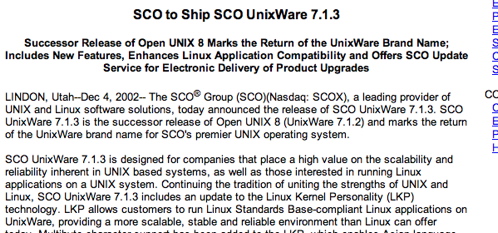
So, OpenUnix was "formerly known as UnixWare". Later, in 2004, SCO announced some upgrades to OpenServer, by then called Legend, and SCO employee Erik Hughes laid out what the future would be for Unix in a slide talk at SCO Forum 2004:
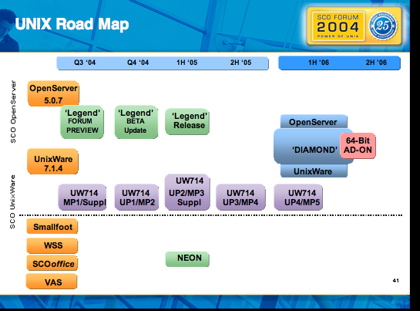
I think it would be hard to argue that Sun would be interested in UnixWare for any conceivable purpose. It had its own Solaris. I can't really say about Microsoft's license, as I haven't finished researching it. What about the other licenses SCO sold? Heaven only knows SCO's description of SCOsource kept changing, and that makes it hard to parse it out, but let's take a look at everything I have at hand so we can see how SCO and the media described it.
What was SCOsource?
The short answer is that SCO sold different things to different entities, depending on what you were using in the way of Linux. They had a SCOsource license to cover everything, even embedded Linux, after all. Their position at the time was that if you were using Linux commercially, you needed a license. But there were essentially two types of things a SCOsource license could cover, as best one can tell by SCO's description, the first version being about shared libraries, a modest program for those wanting to still run Unix applications on Linux after leaving Unix behind. For that one paid a different price than for the other SCOsource license for Linux, which is the license most of us think of when we hear the word SCOsource.
The first version of SCOsource
Here's the SCO press release announcing SCOsource's first deliverable in January of 2003: Key components of today's announcement include:
-- The creation of SCOsource, a division of SCO that will expand the
licensing of the company's core intellectual property, including the
core UNIX source code.
-- The first offering from SCOsource will be SCO System V for Linux -- an
end-user licensed product for use on Linux systems. SCO System V for
Linux provides unbundled licensing of SCO's UNIX System shared
libraries for use with UNIX applications, enabling them to run on
Linux.
Here's a screenshot of a slide from a SCOsource presentation, and as you can see, it involved shared libraries from both UnixWare and OpenServer for use in Linux:
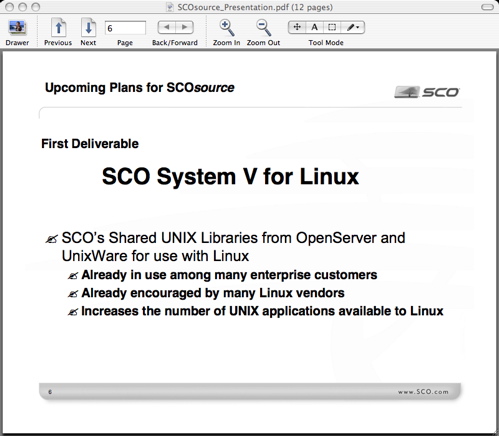
Nevertheless, you will notice that the name for the first deliverable was "SCO System V for Linux." That's because it's all Unix. All of it. UnixWare and OpenServer were based on UNIX. But in any case, you can see on this UnixWare 7 Technical Specifications list from SCO Forum 2004 that it still used the "SVR5 SMP kernel":
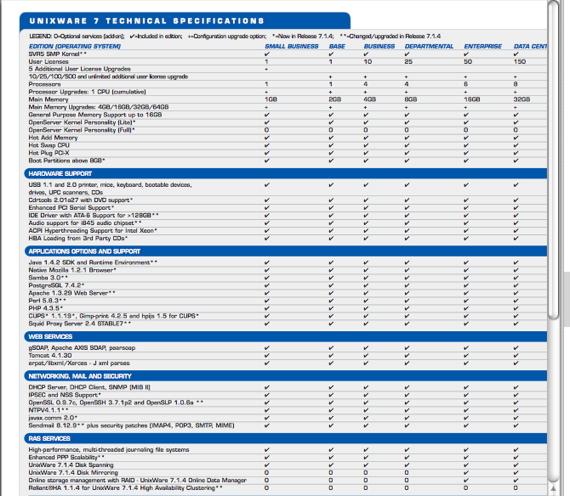 In the next screenshot, from a website Caldera had on UnixWare (the bottom of the page read "© 2001 Caldera International, Inc. All rights reserved.
Open UNIX 8 Release 8.0.0 -- 22 June 2001") , you'll see that in discussing UnixWare ABIs, it called them all "System V ABIs":
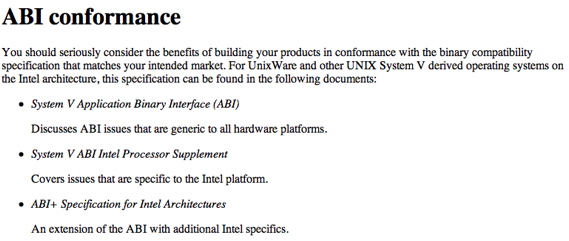
So in the ultimate sense, if you are talking about UnixWare, you can't separate it from Unix. That's what it is, although a derivative. So while the first deliverable under SCOsource had to do with OpenServer shared libraries, it's not the same thing as the later SCO Intellectual Property License
for Linux. That didn't show up until August of 2003. One way you can tell the difference is by the price. The price for the first deliverable was $149:
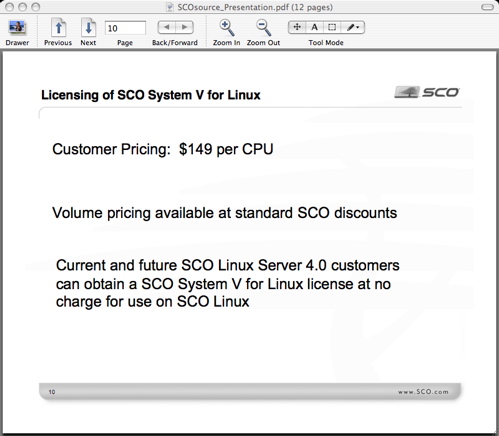 The price for the Linux license was $699 per CPU for server licenses (although one could pay $149 annually instead), and SCO at the time said it would make cheaper licenses available for the desktop and for embedded Linux: The license, called the SCO Intellectual Property License for Linux, lets Linux users run SCO's intellectual property in binary form only. "It gives you a license to run the software only. You can't view the source, and you can't contribute it to an open-source product for everyone's use," Stowell said.
Open-source advocates have said that such a license would violate Linux's GNU General Public License (GPL), which prohibits the Linux source code from being mixed with a license like SCO's, but Stowell disagreed. "This is a license that is designed to run in addition to the GPL," he said....
A single-processor server license will jump to $1,399 after Oct. 15, Stowell said. Well, that's a GPL violation in itself, which is another good reason why the license couldn't be offered. But the court in Novell's motion is just looking at whether SCO, under the APA, could make an offer for such a license at all. My point is simple: it ought to be a snap to determine what precisely any SCOsource licensee bought, the initial or the later license by looking at what they paid. If all they wanted was to switch to Linux and still use Unix applications, they'd buy the first deliverable. Not many did, I gather. And then one can analyze it by looking at what the entity wanted a license to be able to do. But we'll talk about that in Part II. But what we've seen so far is that SCO's own press release said SCOsource was about a number of things, including what it called "the core Unix source code".
Update: Groklaw member rand points out that in the Partners' Training Powerpoint on SCOsource, presented by Jay Petersen, and dated April of 2003, it clearly states that the first offering would be COFF from OpenServer only, and that UnixWare used only ELF, that the latest version was from 1990, and that it would be a later SCOsource offering. Of course, 1990 is too early to belong to SCO. But this indicates, unless the powerpoint is totally wrong, which is possible, that when SCO announced its first offering, it misspoke or at least was not totally accurate. Which is the truth is, of course, unknowable by me and you. But there is a notable mismatch in this picture. As you can see, the powerpoint is still available on SCO's website, which implies they are either standing behind what it says, that UnixWare was not in the first SCOsource offering, or are incredibly sloppy.
Here's what SCO's SCOsource page looked like in April of 2003:

And because the press release announcing SCOsource in January moved away, and I had to try to find it on Wayback, here's how SCO's press release appeared on SCO's website in January of 2003, in three parts, because it was long:
Part 1:
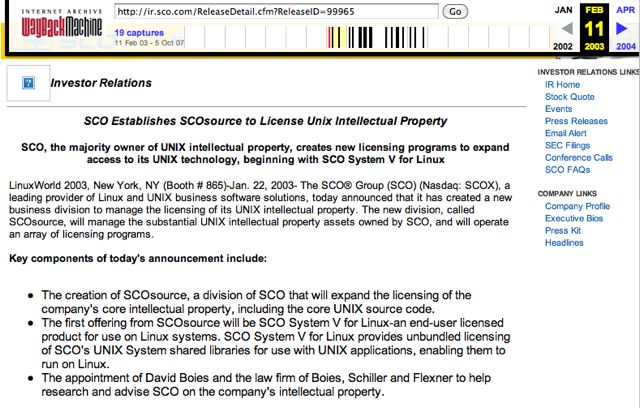
Part 2:
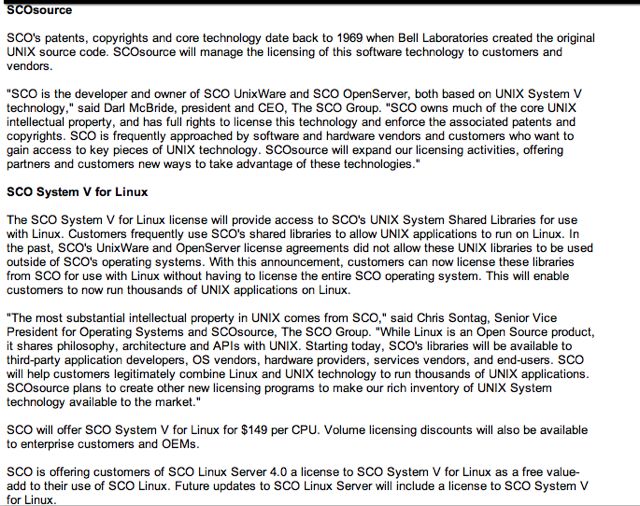
Part 3:
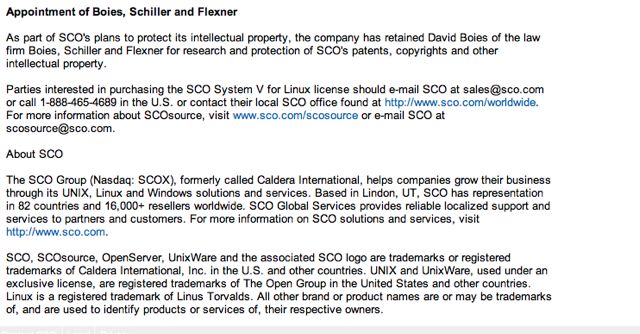
And here's what SCO told its investors that same day, January 22nd:
Part 1:
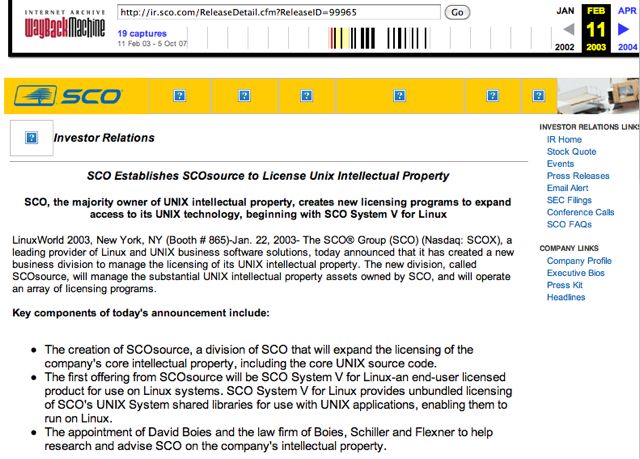
Part 2:
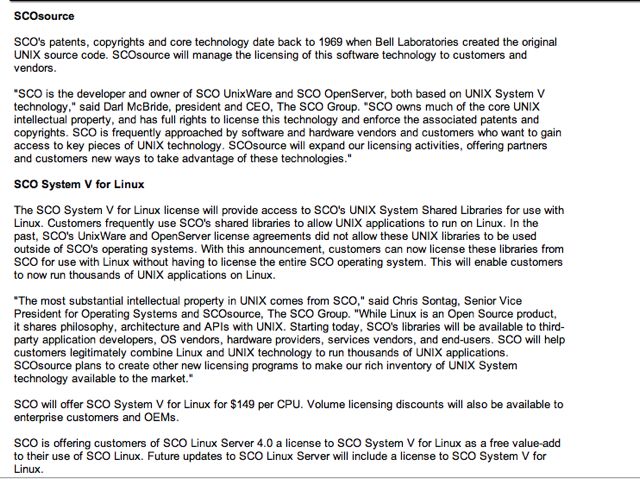
Part 3:
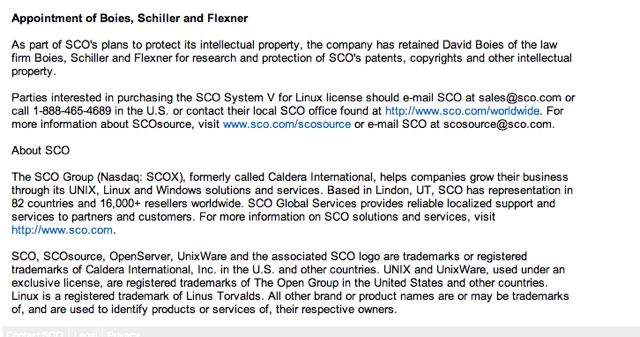
|
|
|
|
| Authored by: rsteinmetz70112 on Wednesday, February 13 2008 @ 04:20 PM EST |
What was the date of that first presentation?
I recall that before Caldera bought OpenServer Santa Cruz developed iBCS. For a
long time Santa Cruz avoided the issue of what type of license was necessary to
actually use their libraries. I recall the issue coming up frequently online,
with no clear answer.
---
Rsteinmetz - IANAL therefore my opinions are illegal.
"I could be wrong now, but I don't think so."
Randy Newman - The Title Theme from Monk
[ Reply to This | # ]
|
| |
| Authored by: DBLR on Wednesday, February 13 2008 @ 04:40 PM EST |
Place Off Topic talk here.
---
"Democracy is two wolves and a lamb voting on what to have for lunch. Liberty is
a well-armed lamb contesting the vote."
Benjamin Franklin.
[ Reply to This | # ]
|
| |
| Authored by: NetArch on Wednesday, February 13 2008 @ 04:50 PM EST |
| Check this out. This is what PJ found from one of Tarentella's
10-k's:
The Santa Cruz Operation, Inc. (SCO or the Company) was
incorporated in California in 1979 and shipped its first product, SCO(R)
XENIX(R) System V, a packaged version of the UNIX(R) operating system, in 1983.
In 1985, the Company introduced its first operating system for the 32-bit
Intel(R) microprocessor environment, SCO XENIX 286, and followed with its SCO
XENIX 386 in 1987.
Er, I think something is wrong here - and I
don't think it's just a typo. Why would SCO name a product for the 32-bit market
after a 16-bit processor - the Intel 80286? That just doesn't make any sense.
And I don't remember a 32-bit version of XENIX, although I may be wrong. My
first exposure to 32-bit Unix was SCO Unix/386 in 1990, and it had been on the
market for a while. I had a copy back in 1988 of SCO Xenix which required a 286
processor. It could run on a 386, but it was only 16-bit code.
Seems even
Tarentella can't get it right. So now we can all forgive SCO - it was just a
misunderstanding. A quote from Emily Litella is in order: "Never mind." Just
kidding! ---
NetArch - building a better Internet one subnet at a
time... [ Reply to This | # ]
|
| |
| Authored by: ak on Wednesday, February 13 2008 @ 04:57 PM EST |
SCOsource Licensing
http://sco.com/scosource/[ Reply to This | # ]
|
| |
| Authored by: Anonymous on Wednesday, February 13 2008 @ 05:06 PM EST |
...of "we're not selling (IP) licenses; we're merely promising not to
sue".
Isn't that the very *definition* of a license--the grant of a permission to do
something that is otherwise prohibited? Or is there a meaningful legal
difference between "you have permission to do X" and "you don't
have permission to do X, but we promise not to enforce rights to prevent
it"?
I can see that argument being laughed out of court.
[ Reply to This | # ]
|
| |
| Authored by: PTrenholme on Wednesday, February 13 2008 @ 05:07 PM EST |
PJ, you said: If we look at the Asset Purchase Agreement of
1995 between Novell and Santa Cruz Operation, in the recitals section at the
beginning of the document, it describes Novell's business like
this:
Seller is engaged in the business of developing a
line of software products currently known as UNIX and UnixWare, the sale of
binary and source code licenses to various versions of UNIX and UnixWare, the
support of such products, and the sale of other products which are directly
related to UNIX and UnixWare (collectively, the
"Business").
See the difference? One was a binary product
and the other was source code. UnixWare was the binary product.
...
I believe the phrase: Seller is engaged in
the business of developing a line of software products currently known as UNIX
and UnixWare, the sale of binary and source code licenses to various versions of
UNIX and UnixWare . . . tells us that both UNIX and UnxWare
were available in "binary" or "source code" versions, not that one was "binary"
and the other was "source."---
IANAL, just a retired statistician [ Reply to This | # ]
|
| |
| Authored by: Anonymous on Wednesday, February 13 2008 @ 05:22 PM EST |
The only SysV stuff SCO was allowed to sell was the code "incidental"
to Unixware. A simpler view of the whole thing is was it a Unixware license? If
not then SCO did not have the right to sell it.
So when customers paid for an SCOsource license if they did not get Unixware
operating on that system then SCO was stepping outside of the domain it was
allowed to operate in.[ Reply to This | # ]
|
| |
| Authored by: Anonymous on Wednesday, February 13 2008 @ 06:05 PM EST |
I think I have the answer. It came to me just now.
It is SO obvious as to (possibly) be correct or completely incorrect.
SCOsource == All of the SCO source code for all of their Unix versions! That is
all it is. The 'right' to include or view the source code that is in the SCO
Unix versions!
Of course, this could be completely absurd and incorrect!
Either way...
Who knows? I do not think even SCO does any more. [ Reply to This | # ]
|
| |
| Authored by: artp on Wednesday, February 13 2008 @ 06:11 PM EST |
Please put a summary of the correction in the title.
---
Userfriendly on WGA server outage:
When you're chained to an oar you don't think you should go down when the galley
sinks ?[ Reply to This | # ]
|
- SVRX? - Authored by: Anonymous on Wednesday, February 13 2008 @ 07:19 PM EST
- SVRX? - Authored by: Anonymous on Wednesday, February 13 2008 @ 09:35 PM EST
| |
| Authored by: artp on Wednesday, February 13 2008 @ 06:13 PM EST |
Refer us to the title so we can put your comments in context.
---
Userfriendly on WGA server outage:
When you're chained to an oar you don't think you should go down when the galley
sinks ?[ Reply to This | # ]
|
| |
| Authored by: Anonymous on Wednesday, February 13 2008 @ 06:13 PM EST |
I may have some insight into this. During the late 80's and 90's I worked for
one of the ATT/USL licensees. We originally had an SVR3.2 license (and IIRC,
SCO OpenServer was based upon this, or an earlier SVR2 license), then when the
AT&T/Sun collaboration produced SVR4, we had two SVR4 source distributions
(one for the Western Union 3B2 processor and one for the i386 processor).
Later, we cooperated with USL (and several other licensees) on a multisystem
distributed version of Unix built on the Chorus microkernel; for this effort we
had the Unixware 2.0 source code. All of the source code flavors build upon
the prior releases, and the difference between SVR4.2ES/MP (the first native
multithreaded pre-emptable orange-book certified version of USL Unix) and
Unixware 2.0 is primarily in the addition of netware support (eg. unixware is a
conflation of unix and netware) through the Univel efforts. There were few, if
any, core kernel differences between SVR4.2ES/MP and Unixware 2.01.
Short answer, there _was_ a Unixware source distribution that was made available
to licensees, by USL, but it was considered just the next release of
SVR4.2ES/MP.[ Reply to This | # ]
|
| |
| Authored by: Jude on Wednesday, February 13 2008 @ 06:19 PM EST |
I'm not sure that even SCO knew what they were allegedly licensing. They
certainly went to great pains to avoid making any specific statements about it.
Perhaps this is because they never bothered to figure it out themselves.[ Reply to This | # ]
|
- Exactly - Authored by: Anonymous on Thursday, February 14 2008 @ 02:55 AM EST
| |
| Authored by: Sique on Wednesday, February 13 2008 @ 07:04 PM EST |
I wonder if companies like Siemens ever were interested in SCOsource licenses.
Their legacy large phone system, the HiPath4000 and its predecessor, the
Hicom300, have a SCO Unix/OpenServer7 based subsystem for diverse management
purposes. The newer systems, especially the HiPath8000 phone switch, is
SuSE-Linux based. While SuSE is now fully owned by Novell and thus even in
NewSCOThink does not need SCOsource licenses, the development of the HiPath8000
is somewhat older.[ Reply to This | # ]
|
| |
| Authored by: Yossarian on Wednesday, February 13 2008 @ 08:10 PM EST |
When Darl claimed that Linux stole SCO's IP, he did not show
code from Unixware, he showed code from UNIX. So if the issue
has been, from the beginning, as SCO claims, about Unixware
then why had Darl shown UNIX code?
(I don't try to argue about SCO's position. I try to
understand how SCO's action fit with SCO's position.
And I hope that Novell will get Darl on the witness
stand and force him to answer the question: "If UNIX IP
was not the issue, then why did you show UNIX code in Linux?)[ Reply to This | # ]
|
| |
| Authored by: Anonymous on Wednesday, February 13 2008 @ 08:12 PM EST |
It was for perpetrating a scam.
Examining the history of UNIX to determine the purpose seems a bit
non-productive. Given that SCO was intentionally vague about what IP it was
licensing, refused to clarify even after several court orders to do so, and
changed their official storyline every few days, its obvious there was never any
real "licensing program".
It was a prop to support the idea of SCO owning UNIX with rights to Linux, and
was tossed out to add to the volume of noise SCO was spouting back when they
still thought IBM would be a quick and easy settlement.
I suspect they hadn't even thought at the time about actually selling any, that
was to be considered AFTER they'd already cowed the world by collecting billions
from IBM (and at which point the industry was supposed to be too scared of being
sued to question what the license actually said.) But IBM didn't immediately
fold, and the lawyers were hinting that follow-thru could get expensive, so they
decided to sell a couple licenses to FUD-hungry IBM competitors at grossly
inflated prices, both to grab the cash, and to pressure IBM some more.
It wasn't until IBM's counterclaims, and Novell challenging the copyright
ownership, that anyone even bothered to ask, and at that point SCO was saying
whatever sounded good for the moment. Unfortunately, several of those moments
contradicted several others, now here we are.
But the purpose was to scam money. No more, no less. There is no valid
connection to UNIX or Linux. Any theories to the contrary are pure fantasy.
[ Reply to This | # ]
|
| |
| Authored by: sirwired on Wednesday, February 13 2008 @ 08:33 PM EST |
The original SCO Source was to license the Shared UNIX Libraries which I do not
believe have ever been GPL'd. This initial version did not include their claims
that Linux in general violated SCO's non-existent rights.
The shared libraries (as it was explained at the time, anyway) enabled you to
run UNIX binaries on Linux. Apparently some Linux users were using these
without paying for them. (This was SCO's story anyway.) This is what is in
those slides you had.
While there are likely countless problems with this (like non-ownership or the
copyrights, pre-GPL'ing or somesuch), this wasn't nearly as offensive as what
came later.
This was on 1/14/03
http://www.news.com/SCO-fees-may-hit-some-Linux-users/2100-1001_3-980514.html?ta
g=item
******
A week later, on 1/22/03 they started making rumblings about programmer
contamination and mention they have hired BSF, but "SCO said it had not
engaged Mr. Boies to take legal action against our fellow Linux vendors."
Already analysts point out that SCO itself is a Linux distributor, and suing
Linux vendors or individuals may not be a good idea, and is unlikely to get
people to switch to "SCO Linux".
http://www.news.com/SCO-casts-wider-net-for-infringers/2100-1001_3-981569.html?t
ag=item
This does not raise much of an outcry at this time, and there are no followup
articles on it, although apparently some interviews were done by CNet that did
not get used in this article, but they are mentioned later.
*****
Then, on 3/6/03, the famous bomb drops:
http://www.news.com/SCO-sues-Big-Blue-over-Unix%2C-Linux/2100-1016_3-991464.html
?tag=item
"It's a fairly end-of-life move for the stockholders and managers of that
company," said Jonathan Eunice, an Illuminata analyst. Eunice turns out to
be pretty accurate in this article, calling B.S. on some of SCO's claims on the
very first day, while mentioning that some of the others may have to wait for
evidence to roll in.
Some other choice quotes by this guy:
"If there's any impact on Linux, it'll be principally through fear,
uncertainty and doubt," he said. "The principal winners in that would
not be SCO, but Microsoft and potentially Sun."
and
"Eunice, who has been involved in Unix for years, questioned the accuracy
of some of the history contained in the SCO suit. For example, the suit says
that "AIX is a modification of (SCO's) licensed Unix that is designed to
run on IBM's processor," but Eunice said IBM was unhappy with the
performance of Unix kept only the interfaces higher-level software used to
communicate with it.
"The AIX kernel...was not principally based on the Unix source code. It was
based on their (IBM's) own development," Eunice said. "
This guy was <i>good</i>. Maybe we could wrangle some sort of
interview here where we congratulate him for his foresight? Nothing from DiDio,
Enderele, or Lyons is in this article.
There are also some quotes from SuSE and IBM from earlier interview when that
shared library stuff broke, but nothing different than what you would expect
them to say. (That is not to say they were wrong; they weren't. Just that
nothing they are quoted as saying is unexpected.)
SirWired[ Reply to This | # ]
|
|
|
|
|



